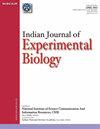Utility of risk prediction nomogram for lymph node metastasis in the elderly with undifferentiated early gastric cancer
IF 0.7
4区 生物学
Q4 BIOLOGY
引用次数: 0
Abstract
Gastric cancer (also called stomach cancer) is the 5 th most common cancer the human population suffer from, particularly in East Asia. For effective prevention, it is important to find biomarkers for early-stage diagnosis and prognosis. Further, finding the risk factors that are associated with undifferentiated early gastric cancer is the utmost required. Here, we explored the clinicopathological characteristics of undifferentiated early gastric cancer (EGC) in the elderly, and the risk factors for lymph node metastasis. A total of 187 elderly patients with undifferentiated EGC were selected as subjects, whose clinical data were analyzed retrospectively. They were divided into lymph node metastasis and non-lymph node metastasis groups, and the risk factors for lymph node metastasis were analyzed by univariate and multivariate logistic regression analyses. A nomogram model was established to predict the risk of lymph node metastasis, and then validated. Lymph node metastasis was detected in 32 (17.11%) of the 187 cases. Univariate analysis showed that tumor diameter, depth of invasion, vascular tumor thrombus and local ulcer affected lymph node metastasis ( P <0.05). Multivariate logistic regression analysis revealed that tumor diameter >2 cm, invasion to submucosa, vascular tumor thrombus and local ulcer were independent risk factors ( P <0.05). The nomogram model was constructed based on the independent risk factors, and its concordance index and area under the receiver operating characteristic curve were 0.756 (95%CI: 0.684-0.830) and 0.758 (95%CI: 0.701-0.815), respectively. Calibration curve and model calibration curve suggested that the predicted probability of the model was consistent with the actual one, indicating high accuracy. Lymph node metastasis of the elderly with undifferentiated EGC is affected by many factors, among which tumor diameter >2 cm, invasion to submucosa, vascular tumor thrombus and local ulcer are independent risk factors.风险预测列线图在老年未分化早期癌症淋巴结转移中的应用
癌症(也称癌症)是癌症患者中最常见的第五大癌症,尤其是在东亚地区。为了有效预防,重要的是找到早期诊断和预后的生物标志物。此外,最需要的是找到与未分化早期癌症相关的危险因素。在此,我们探讨了老年人未分化早期癌症(EGC)的临床病理特征,以及淋巴结转移的危险因素。共选择187例老年未分化EGC患者作为受试者,对其临床数据进行回顾性分析。将其分为淋巴结转移组和非淋巴结转移群,并通过单变量和多变量逻辑回归分析淋巴结转移的危险因素。建立列线图模型来预测淋巴结转移的风险,然后进行验证。187例中有32例(17.11%)淋巴结转移。单因素分析显示,肿瘤直径、浸润深度、血管瘤栓和局部溃疡影响淋巴结转移(P 2cm,浸润粘膜下层、血管瘤血栓和局部溃疡为独立危险因素)(P 2cm、浸润黏膜下层、血管癌栓和局部破坏为独立危险因子)。
本文章由计算机程序翻译,如有差异,请以英文原文为准。
求助全文
约1分钟内获得全文
求助全文
来源期刊
CiteScore
1.57
自引率
33.30%
发文量
84
审稿时长
6 months
期刊介绍:
This journal, started in 1963, publishes full papers, notes and reviews in cell biology, molecular biology, genetic engineering, endocrinology, reproductive biology, immunology, developmental biology, comparative physiology, radiation biology, chronobiology, microbiology, pharmacology, toxicology and other biological fields including instrumentation and methodology. The papers having experimental design involving alteration and/or manipulation in biological system(s) providing insight into their functioning are considered for publication. Studies involving higher animals, human beings and of clinical nature are not encouraged for publication in the journal.

 求助内容:
求助内容: 应助结果提醒方式:
应助结果提醒方式:


